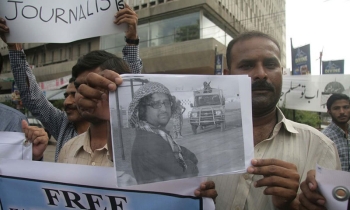Jayson Blair may have used his color as a shield against the radar at The New York Times. But blaming diversity when personnel problems go terribly awry, as they did in this instance, is like blaming expensive and delicate machinery for malfunctioning when the workers don't have operating manuals.
The drive for diversity is a business imperative. According to the U.S. government's Minority Business Development Agency's report, "The Emerging Minority Marketplace," America's multiethnic purchasing power may reach $4.3 trillion by 2045, up from $1.3 trillion in 2000. Even if newspapers don't really want to reach those multiethnic customers, their large corporate advertisers will insist on it.
To increase circulation in the emerging markets, mainstream newspapers first have to create a product ethnic readers find credible. Each day's news report is like a giant puzzle. Each new cultural perspective included from special populations – youth, women, and ethnic or racial groups – adds clarity and provides insight. When newspapers present only the majority view, as many now do, they are giving their readers only a piece of the puzzle.
So there is no turning back. That means we must learn how to manage diversity, to operate the machinery in an even-handed way. And that, in turn, means dealing straightforwardly with the people inside newsrooms who tend to derail diversity programs and ruin the programs' reputation. I have met such people in every newsroom I have worked in, and they tend to hold back progress. Who are they?
The Parents: The editors who believe that some journalists should be held to lower standards because race or ethnicity puts them at a disadvantage. This paternalistic practice undermines the professional development of journalists of all colors. I have known editors who overlooked grammatical errors by blacks (because they came from inferior schools) and reporting deficiencies by whites who lacked the cultural skills or courage to report from poor, multiethnic neighborhoods. Jayson Blair seems to have met his share of "parents" at the Times.
The Victims: The "I didn't get that job because I'm the wrong color" attitude, which excuses reporters and editors of all colors from examining their own faults and weaknesses.
The Bullies: Journalists who gain power in their newsrooms by engaging in disruptive behavior or bullying of their colleagues. Editors often are afraid to talk to them, provide feedback, or to fire them. Within this group you will find "the angry black man," "the angry white man," and the "plotters," who smile in your face but look for ways behind your back to sabotage the newspaper.
The Colorblind: Journalists who feel that their cultural identities, experiences, values, and beliefs never affect the way they report or edit stories. Since they are colorblind in their own minds, they tend to believe that all other views and people are biased. They seek conformity, not diversity.
The Superiors: This is a variation of the Colorblind, except that the Superiors feel that only people who think like them, act like them, and talk like them can perform well. They, too, value conformity, but want others to convert to their world view. They do not believe that two people can look at the same situation, draw different conclusions, and both be right.
On the other side of the ledger, managing diversity well means seeking ways to reward reporters and editors who achieve cultural competency, meaning they understand how cultures differ and can report and edit across cultural lines. That certainly doesn't require lower journalistic standards. It requires new skills and global literacy, and it requires us to learn to identify and manage the biases we bring into the newsroom each day. By working on ours.









